Everdrive N8 & Famicom Expansion Audio into NESRGB Mod:
With the Everdrive N8 new firmware coming soon featuring improved expansion audio emulation (especially for VRC6 in Japanese Castlevania III), I decided to make a web guide with pictures on how to mix the expansion audio from the Everdrive N8 and/or a Famicom-to-NES adapter into the NESRGB board installed on a front-loader NES such that you get a near perfect balance from the audio output. This guide is based on volume level 35 audio for VRC6 mapper which was improved by 'Slamy' and implemented by Krikzz.
Special thanks go out to Voultar and Tim Worthington for their own suggestions and methods of mixing the expansion audio.
Please Note:
If you don't have access to volume control of expansion audio, you can force the current official firmware to use the same sound volume of 35 for the VRC6. Simply replace the "024.RBF" file in the EDFC >> MAPS folder on your SD card with the one zipped in the link below:
VRC6 Volume 35 Map for Everdrive N8
Simply delete the old 024.RBF file, unzip the new one, and put it in place of the old one. If at any point the firmware Krikzz comes out with changes the volume again, simply hold onto that zip file and use it to re-plant the 024.RBF mapper as needed. Cheers!
Important:
Be sure to unplug the NES from the power supply and then try to turn the NES on unplugged. This will drain the stored energy in the console, which you can see gets discharged when the power LED blinks for a split second. One time I forgot to do this, and when I was taking the metal shroud off the bottom, I saw a large spark eminate from the RF/Power box when the shroud grazed it. I was quickly reminded of my mistake, so please make sure you de-energize the NES before you open it!
Now onto the Mod:
1. Unscrew the console shell top, top metal shroud, and cartridge interface slot, then remove the cartridge interface slot from the console. If you're using an Everdrive N8, then you 'should' be using a "Blinking Light Win" kit. If you don't have one, get one. Seriously, get one asap.
2. Unscrew the RF/Power box screws and carefully lift the entire NES board + bottom shroud up off the peg stands. Now turn the board + bottom shroud over to the right (the console's front should be facing you when doing this). In the photo below, you'll want to unplug these blue and green socket connectors depicted:
|
|
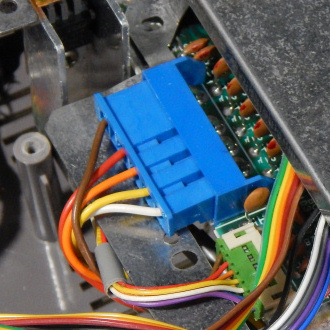
|
3. After you unplug the sockets, you should be able to easily lift the bottom shroud up and then turn it over towards the left (being mindful of the various NESRGB wires tha are likely fed through it on that side). With full vew of the NESRB board, you'll notice a hole in the board near the "J5" jumper designation label. We want to solder a 16-inch single line of shielded 28 AWG multi-strand ribbon wire to this hole. My technique is to strip about 3mm of shielding off the wire and then 'tin' the expose strands. This turns them effectively into a solid line, which makes for easy insertion into the NESRGB's 'mixing port' as I like to call it. I apply some no-clean liquid flux to the wire after placing it where I want in the mixing port, and then tack-weld it in place with a small droplet of solder on the tip of my iron. Your results should look similar to my blue wire in the center of the image here:
|
|
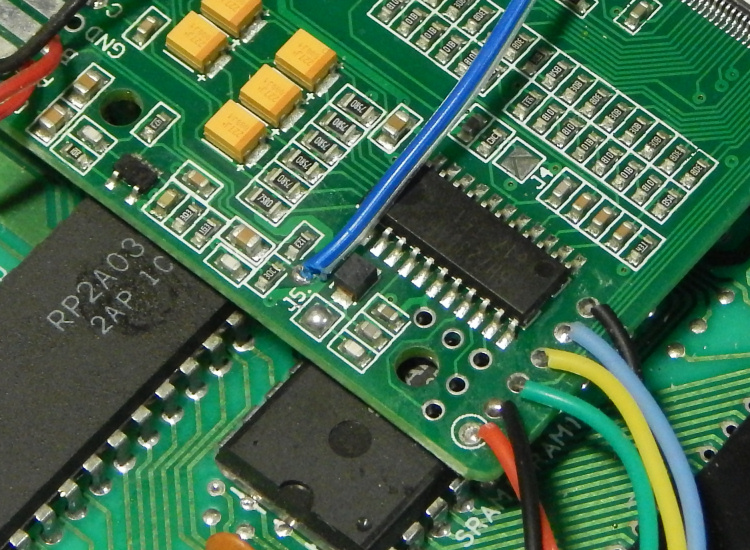
|
4. Now return the bottom metal shroud to the board, making sure to feed the new audio mixing wire through it in the same areas as the other NESRGB wires. Also be sure to re-connect those blue and green sockets back onto the board. In the image below, you can see my particular choice of where I feed the new audio line through the bottom shroud:
|
|
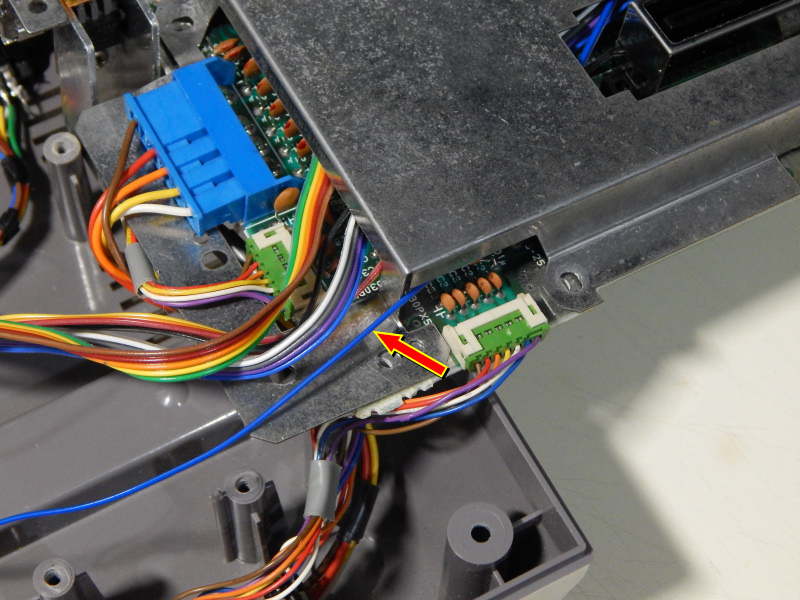
|
|
Phase 2:
5. Take your new audio wire feed coming from the NESRGB (or optional toggle switch) and bring it towards the front of the console. Now flip the NES mainboard + bottom shroud carefully back over and align it back onto the plastic pegs. Make sure on the right side that no wires are getting pinched by the plastic standoffs. Inspect this carefully and check to make sure all plastic pegs are lined back into the holes of the board and shroud.
6. With that done, it's time to add the attenuating resistor. My choice based on the Beta 20 firmware is to use 47K Ohms. Note that's 47,000 Ohms, not 4,700. Because I may feel the need to change the resistor value at some point, I prefer to tack it directly to the wire, then tack another line of wire on the other side of the resistor before connecting it to the top of the NES board. As such, I leave a bit of slack in the line so I can easily access this resistor immediately after taking the top shell off the NES. This is just my preferred method, whereas you may prefer Voultar's method of tacking the resistor directly to the NES mainboard with no slack in the wire. How you choose to proceed on this step is up to you, but provided below is my method, and you'll see I slipped on some shrink tubing before tacking the resistor to the wires:
|
|
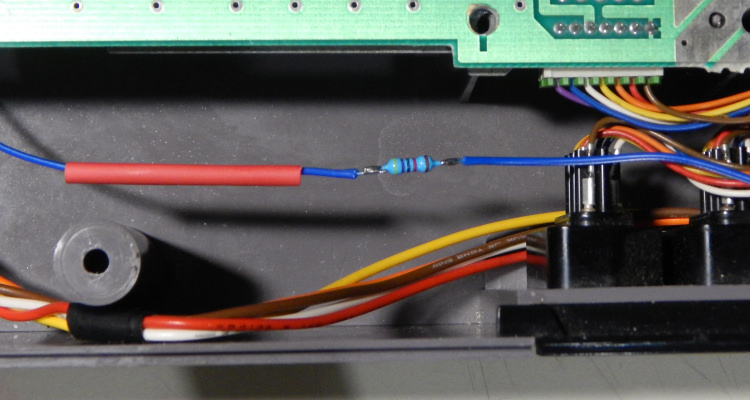
|
Then I slide the shrink tubing into place and use my 858D hot air station to activate the tube. It's important to not use too high a temperature on your hot air station, or you might scortch the wire shielding and/or melt it. I've found through practice that setting the 858D to 180 degrees makes for a perfect shrink tube setting. You can blast away at that shrink tube with no fear of melting the wire:
|
|
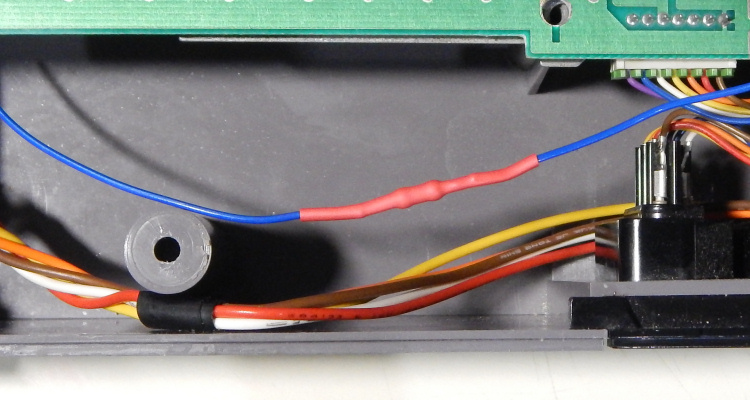
|
7. We're on the home stretch! So now we need to grab a 1K Ohm resistor (1,000 Ohms) and use it as a pull-down to prevent noise leakage from the Everdrive N8's expansion audio channel when it's not being used. Now a word about this value of 1K Ohms: I spent two days obsessively recording audio from the NES with various pull-down resistor values from 3.3k all the way down to a lowly 100 Ohms. Voultar's own suggested range is anywhere between 3K and 4K Ohms, but I found from this research that optimal noise reduction is maximized at 1K Ohms. The mixed expansion music for Beta 20 firmware plays perfectly fine at this rating, and so 1K Ohms is my personal recommendation for the most effective noise cancellation. Anything lower than that will give severely diminished returns, so 1K is peak performance in my opinion.
Right, so getting on with it, lay the resistor across the expansion port audio pins on the top of the NES mainboard (this is the area underneath where the cart slot normally sits). Determine how long you need the legs of the resistor to be in order to reach and solder to pins 2 and 9. Keep in mind I said 2 and 9, not 3 and 9 (some previous mod work made use of pin 3 for feeding audio to the NES's own output, but we don't need that for the NESRGB board).
Once you've determined the right lengths for the resistor legs, snip them and then slide on a cut-to-length piece of shrink tubing. This step of using more shrink tubing may seem excessive, by I feel better with everything insulated and no chance of shorting to any of the other pins.
8. With the shrink tubing in place, bend the legs slightly inward around pins 2 & 9, then solder them in place.
Now take the audio feed wire with the 47K Ohm resistor on it and solder the end of the wire to pin 9 as well. Everything in place should look like my work below:
|
|
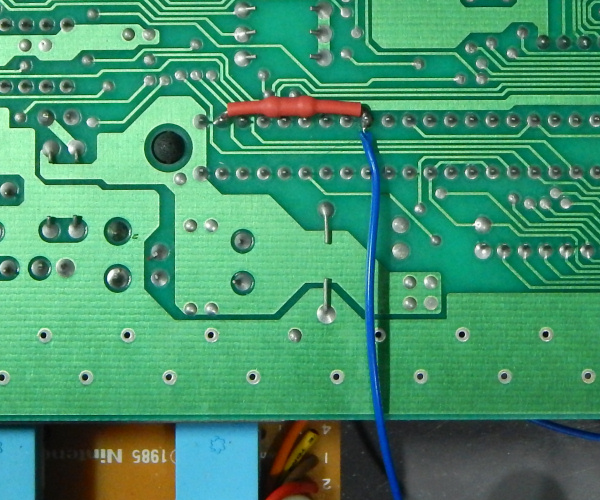
|
9. So now we need to wire up the Famicom-to-NES cart adapter in order to pass expansion audio from real Famicom carts as well. Here's a picture of a cheap on I bought off ebay (with Akumajou Densetsu inserted to show proper orentation):
|
So here you can see I've soldered some 30 AWG kynar wire onto pin 46 of the Famicom side of the adapter and routed it through the ground via as seen in the photo below:
|
10.And below you can see I've flipped the board over and soldered the other end of the kynar wire to pin 54 of the NES side of the adapter:
|
And that's it! Put everything back together and try out some Akumajou Densetsu! A couple photos showing the Blinking Light Win kit in combination with either the Everdrive N8 or a Famicom Cart with adapter:
|
|